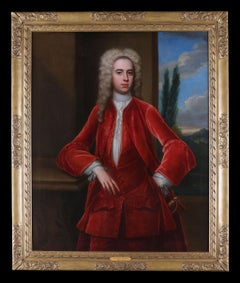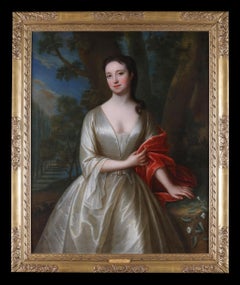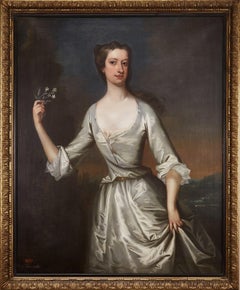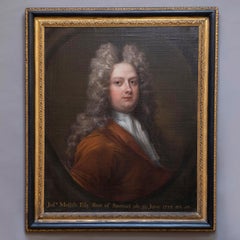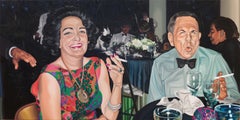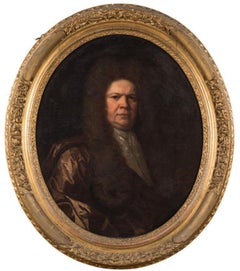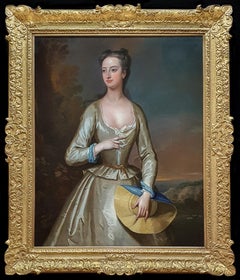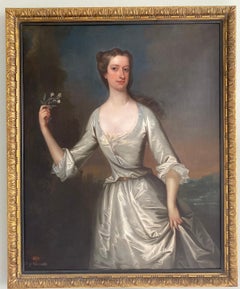Charles Jervas Art
Irish, 1670-1739
Charles Jervas was born in Dublin in 1675 who later lived in England. After moving to England, Jervas became an apprentice to the painter Sir Godfrey Kneller. He later studied drawing in Rome and then returned (c. 1709) to England. Succeeding Kneller, he became court painter to the English kings George I and George II. His home became a centre for literary figures, among them Alexander Pope and Jonathan Swift, whose portraits Jervas painted, in addition to that of George II (1728). He produced a translation of Miguel de Cervantes’s Don Quixote (published posthumously, with his surname spelled Jarvis, in 1742).(Biography provided by Everett Fine Art)
to
6
5
5
1
1
4
Overall Height
to
Overall Width
to
3
5
4
2
2
2
1
1
1
1
6
6
6
6,886
3,210
2,514
1,217
6
6
2
2
Artist: Charles Jervas
Portrait of a Man possibly Arthur Viscount Irwin, Temple Newsam Oil on canvas
By Charles Jervas
Located in St. Albans, GB
Charles Jervas
Possibly Arthur, 6th Viscount Irwin (Temple Newsam)
Oil on Canvas
Picture Size: 50 x 40"
Outside Frame Size: 58 x 48"
1675 – 1739
Charles Jervas, who was born in Cl...
Category
Early 1700s English School Charles Jervas Art
Materials
Oil
Portrait of a Lady possibly Frances Thynne, Lady Worsley 1673-1750 Oil on canvas
By Charles Jervas
Located in St. Albans, GB
Charles Jervas
Possibly Frances Thynne, Lady Worsley 1673-1750
Oil on Canvas
Picture Size: 50 x 40"
Outside Frame Size: 58 x 48"
1675 – 1739
Charles Jervas, who was born in Clonli...
Category
Early 1700s English School Charles Jervas Art
Materials
Oil
English 18th century portrait of Henrietta Pelham-Holles, Duchess of Newcastle.
By Charles Jervas
Located in Bath, Somerset
Portrait of Henrietta Pelham-Holles (née Godolphin) (1701-1776), Duchess of Newcastle, standing in a wooded landscape with a river beyond, three-quarter length wearing an ivory silk ...
Category
1720s Old Masters Charles Jervas Art
Materials
Oil, Canvas
Portrait Of 1st Baron Hawkstone, Sir Rowland Hill, Tory MP for Lichfield
By Charles Jervas
Located in Blackwater, GB
Portrait Of 1st Baron Hawkstone, Sir Rowland Hill, Tory MP for Lichfield (1705-1783)
by Charles JERVAS (1675-1739)
Large 18th Century portrait of Baron Hawkstone, Sir Rowland Hill,...
Category
18th Century Charles Jervas Art
Materials
Canvas, Oil
Portrait by Charles Jervas of Henrietta Pelham–Holes, Duchess of Newcastle.
By Charles Jervas
Located in Taunton, GB
This charming 17th Century half length portrait by Charles Jervas is believed to be of Henrietta Pelham–Holes, Duchess of Newcastle. The sitter is wearing a blue silk gown.
Circa 1700
Oil on Canvas
27 x 19 1/2 inches
68.5 x 49.5 cm
In a fine gilded carved wood frame.
ABOUT THE SUBJECT:
The sitter of svelte poise depicts grace and style. Stylistically taking the fancy of the moment with clearness and brilliancy in his flesh tints. Jervas work follows the English eighteen century tradition of portrait painting, epitomized by the likes of Kneller and Dahl.
Henrietta "Harriet" Pelham-Holles, Duchess of Newcastle upon Tyne, was the wife of British statesman and prime minister Thomas Pelham-Holles, 1st Duke of Newcastle. She was the daughter of Francis Godolphin, 2nd Earl of Godolphin, and Henrietta Churchill, 2nd Duchess of Marlborough. She was also the granddaughter of Sidney Godolphin, 1st Earl of Godolphin, as well as John Churchill, 1st Duke of Marlborough, and Sarah Churchill...
Category
Early 18th Century Old Masters Charles Jervas Art
Materials
Oil
Charles Jervas, Portrait of Joseph Mellish
By Charles Jervas
Located in London, GB
Charles Jervas (1675-1739)
Portrait of Joseph Mellish (1675-1733)
Oil on canvas; held in a carved period frame
Dimensions refer to size of frame.
Provenance: Blyth Hall, Nottinghamshire, England; by descent to Sir Andrew Buchanan of Hodsock Priory, Nottinghamshire
In 1635 John Mellish, a merchant tailor of London, bought the estate of Blyth in Nottinghamshire. His son, a wealthy Oporto merchant, dying unmarried, left Blyth in 1703 to a cousin, Joseph Mellish, who became one of Newcastle’s earliest and most important political supporters in the county. He went up to Clare College, Cambridge in 1692 and on to the Inner Temple the following year. He married Dorothea Gore, daughter of Sir William Gore...
Category
Early 18th Century Old Masters Charles Jervas Art
Materials
Oil
Related Items
Large Contemporary Oil Portrait of Party People Smoking, Laughing, and Drinking
By Nancy Lamb
Located in Fort Worth, TX
The Menthol Mood, 2009, Nancy Lamb, Oil on canvas, 48 x 85"
Nancy Lamb (American, born 1956), sculptor and painter. Formally trained at Texas Christian Un...
Category
2010s American Realist Charles Jervas Art
Materials
Canvas, Acrylic, Oil
H 48 in W 85 in D 2.5 in
Michael Dahl (circle) 17th century portrait of Sir William Cowper
By (Circle of) Michael Dahl
Located in York, GB
Portrait of Sir William Cowper [1639-1706] Circle of Michael Dahl
17th century oval, bust-length, with a long dark wig, and wearing a lace cravat and bro...
Category
17th Century Old Masters Charles Jervas Art
Materials
Oil
Free Shipping
H 38 in Dm 33.08 in
Oil Portrait of a Victorian Lady, c. 1850
Located in Chicago, IL
Painted in the 19th century, this exquisite miniature portrait wonderfully exemplifies realism in traditional oil painting. The small artwork is painted in the conventional portraiture style of the Old Masters, and achieves soft realism with fine brushwork and a subdued, neutral palette. The half length portrait depicts a fine Victorian woman dressed in all black with a delicate lace collar and bonnet. She wears a ruby broach...
Category
Mid-19th Century Old Masters Charles Jervas Art
Materials
Oil
GEORGE ROMNEY(after)19th century portrait The Hon.Reverend Anchitel Grey as a Bo
By George Romney
Located in York, GB
A fine painting after George Romney of The Hon.Reverend Anchitel Grey (1774 – 1833) as a Boy
The painting depicts a boy aged about ten, standing, turned to the left, gazing at the spectator, wearing a blue coat, and white linen collar, a spaniel with its paws on his chest. Shoulder length brown hair. Trees in the background on the right, distant horizon with cloudy sky on the left.
The sitter was the third son of George Harry Grey, 5th Earl of Stamford (1765-1845) and Lady Henrietta Cavendish-Bentinck (died 4th June 1827), daughter of the 2nd Duke of Portland...
Category
19th Century Old Masters Charles Jervas Art
Materials
Oil
Free Shipping
H 36.62 in W 31.89 in D 1.58 in
Portrait of a Gentleman in Armour and Holding a Baton, Manor House Provenence
Located in London, GB
Titan Fine Art present this accomplished work, from Kilcooley Abbey, Co Tipperary, Ireland. It portrays a gentleman traditionally known as the English military commander and politic...
Category
17th Century Old Masters Charles Jervas Art
Materials
Canvas, Oil
H 56.7 in W 46.86 in D 2.76 in
Vintage English Woman with Duffel Coat & Mary Jane Shoes 1960's 1970's England
Located in Preston, GB
Vintage English Woman with Duffel Coat & Mary Jane Shoes 1960's 1970's England entitled 'The Fall of Desire' by Retro Nostalgic Artist, Paul F Harding. ...
Category
Late 20th Century English School Charles Jervas Art
Materials
Canvas, Cotton Canvas, Oil, Acrylic
Portrait of an Elegant Lady in a Red Silk Dress, Beautiful Antique Frame c.1720
By Jonathan Richardson the Elder
Located in London, GB
This beautiful portrait was painted circa 1725 and is a fine example of the English eighteenth century portrait style. The artist has chosen to depict the lady against a plain background wearing a simple red silk dress and transparent headdress hanging down the back. The sitter is not shown with jewellery or any other elements to distract the viewer’s attached, thus highlighting the beauty of the young sitter. This restrained manner achieves a sense of understated elegance.
The portrait genre was valued particularly highly in English society. Neither landscapes nor allegorical pictures were ever priced so highly at exhibitions and in the trade as depictions of people, from the highest aristocracy to scholars, writers, poets and statesmen. With the rich colouring and lyrical characterisation, these works are representative of the archetypal English portrait and is are very appealing examples of British portraiture...
Category
18th Century Old Masters Charles Jervas Art
Materials
Canvas, Oil
H 37.41 in W 28.94 in D 1.97 in
17th century portrait of Lady Sarah Cowper, Circle of Michael Dahl
By (Circle of) Michael Dahl
Located in York, GB
Portrait of Lady Sarah Cowper, nee Holled [1644-1720]-Circle of Michael Dahl 17th century,
oval,bust-length . She has dark hair tied high and wearing a b...
Category
17th Century Old Masters Charles Jervas Art
Materials
Oil
Free Shipping
H 38 in Dm 33.08 in
Male and female portrait, both in silk kimono, possibly textile dealers
By Christoffel Lubieniecki
Located in Amsterdam, NL
CHRISTOFFEL LUBIENIECKI (1659-1729)
Pair of portraits of a gentleman and a lady, both in silk kimono, before a country house (circa 1680)
Indistinctly signed “C.......” on a box under the man’s left hand
Oil on canvas, 79.5 x 67 cm each
Both sitters are portrayed wearing a silk “Japanese” coat. During the second half of the seventeenth the Japanese silk coat, an adapted Japanese kimono, became a real vogue in the Dutch elite. The exclusive Dutch trade contacts with Japan can explain the popularity of the kimono-style silk coats in the Netherlands. Everybody who could afford one, dressed in such a fashionable and comfortable coat and, like the present sitters, some proud owners had themselves portrayed in a “Japanese” coat often together with an oriental carpet to underline their standing and international connections. These portraits are the work of the Polish-born portraitist Christoffel Lubieniecki (also known as Lubienitski, Lubinitski or Lubiniecki)
Lubieniecki was first trained in Hamburg under Julian Stuhr and after 1675 in Amsterdam under Adriaen Backer and Gerard de Lairesse. He specialized in landscapes, generally of an Italianate character, and in portraits. The loving execution of these contented burghers, enjoying the garden vistas of their country house, places him alongside Amsterdam portraitists such as Constantijn Netscher and Michiel van Musscher...
Category
1680s Old Masters Charles Jervas Art
Materials
Canvas, Oil
Free Shipping
H 31.34 in W 26.38 in D 1.97 in
Portrait of a Gentleman in Armour and Mauve Cloak c.1740; Louis Tocque, Painting
Located in London, GB
The sitter in this superb portrait, presented by Titan Fine Art, is shown with the grandiloquence characteristic of the eighteenth-century French school of painting. The young nobleman has been portrayed wearing an ingeniously embellished French ceremonial armour, a mauve cloak, and an abundance of cascading curls falling below his shoulders. Our portrait proclaims to every onlooker that this is a superior being.
The manner in which portraits were painted was set out by the terms of the commission and usually marked significant life events such as a betrothal, a death, elevation of rank… but they almost always emphasised the wealth and importance of the sitter. This type of portrait had become a standard format for aristocratic portraiture in Europe during the last quarter of the seventeenth century up to the middle of eighteenth century. Incorporated into the background was often a raging battlefield or a military encampment; our portrait is free from these trappings and contains a dramatic moody sky ensures the viewer focuses mainly on the subject.
The features of the sitter’s face have been captured with great sensitivity, his confident gaze perhaps reflecting the near invincibility afforded by this steel suit. The flamboyance and penetrating sense of character, lending an air of noble expectancy to the composition, seems almost eclipsed by the artist's virtuosic handling of paint. It is not hard to understand why many wealthy sitters commissioned the artist to paint their portraits.
Such fine and ornate armour was not actually used on a battlefield and thus its portrayal in portraiture was largely symbolic of a sitter’s wealth and status as well as a claim of succession to a chivalrous tradition. The style of hair and neckcloth were fashionable circa 1740.
Held in an exquisite eighteenth century carved and gilded frame - a fine work of art in itself.
Louis Tocqué was a very successful French portrait painter active during the Rococo period of art. His work was known for its attention to detail, its portrayal of the character of the sitter, the refined postures, and the delicacy of the rendered draperies. He created both realistic and expressive portraits.
Tocqué was born in Paris in 1696 and trained with the famous portrait painters Hyacinthe Rigaud, Nicolas Bertin, and Jean Marc Nattier whose daughter he later married. He entered the Academy in 1731 and became a full member in 1734 with his portraits of Galloche and the sculptor Jean Louis Lemoine, and he pursued a brilliant career as a portrait painter, receiving numerous commissions from members of the French aristocracy and royalty. His works were highly sought after by collectors of the time, and his reputation earned him the appointment of official portrait painter to the court of France in 1746 – in fact he stayed at most of the courts in northern Europe.
From 1737 to 1759 he exhibited a large number of works at the Salon. Tocqué's paintings can be found in museums and private collections around the world.
Recent sales...
Category
18th Century Old Masters Charles Jervas Art
Materials
Canvas, Oil
H 38.19 in W 33.08 in D 2.76 in
Portrait of a Lady in Red Dress on Porch c.1680, English Aristocratic Provenance
Located in London, GB
Presented by Titan Fine Art, this painting formed part of a historic collection of an English aristocratic family, Lord and Lady Sandys at their magnificent baroque and Regency Grade-I listed family home, Ombersley Court. The house was among the most fascinating survivals of its kind in this country. The atmospheric interiors were distinguished above all for the works of art associated with two key moments in national history. The collection was acquired or commissioned over five centuries and remained at Ombersley Court until its recent sale, the first in 294 years. This portrait hung in the Grand Hall.
This exquisite grand manner work is an evocative example of the type of portrait in vogue during a large part of the seventeenth and eighteenth centuries. The artist has depicted an elegant lady, three quarter length and seated on porch with a luxurious crimson swag curtain by her side. The clothing – known as “undress” at the time, consists of red silk fastened at the front and sleeves by large gold and diamond jewels over a simple white chemise. In her lap she holds a blue wrap and in her other hand, at her chest, she clutches the end of a sheer gauzy scarf that has been draped around her body with the other end a type of headdress – this type of sheer scarf was often employed by Wissing in his portraits. The classical architecture signifies cultivation and sophistication and the luxurious swag curtain is a signifier of wealth. The portrait can be dated to circa 1680 based on the sitter’s attire, the “hurluberlu” hairstyle, and other portraits by Wissing using the same formula.
This oil on canvas portrait has been well cared for over its life, which spans almost 350 years. Having recently been treated to remove an obscuring discoloured varnish, the finer details and proper colour can now be fully appreciated.
Once owned by Evesham Abbey, the manor of Ombersley was acquired by the Sandys family in the early 1600s, when Sir Samuel Sandys, the eldest son of Edwin Sandys, Bishop of Worcester and later Archbishop of York, took a lease on the manor, before receiving an outright grant in 1614. The present house, Ombersley Court, dates from the time of Samuel, 1st Lord Sandys, between 1723 and 1730. The house itself is a fine example of an English Georgian country house set in rolling countryside and surrounded by Wellingtonias, planted to commemorate the Battle of Waterloo by Arthur Hill, 2nd Baron Sandys, who played a distinguished part in the battle and was one of the Duke of Wellington’s aides de camp. The Duke also stayed in the house and in the Great Hall, was the Waterloo banner which was brought to the house by Sir Arthur Hill, aide-de-camp to the Duke of Wellington, who succeeded his mother, the Marchioness of Downshire as 2nd Lord Sandys. Further Waterloo memorabilia are kettle drums from battle. The family had a strong tradition of military and political service, dating back to the 17th century, and this was also reflected in the fine collection of portraits and paintings in the house. In short, Ombersley represented a vital aspect of British history. The house and more especially the collection were of the greatest historical importance. Houses that have remained in the possession of the same family for as many as three centuries have become increasingly rare.
Through this portrait, collectors have a chance to acquire a piece of British history and an evocative vestige of a glittering way of life, which is now gone.
Much of the attractiveness of this portrait resides in its graceful manner and the utter beauty of the youthful sitter. Presented in a beautiful carved and gilded period frame, which is a work of art in itself.
Willem Wissing was a Dutch artist who enjoyed a solid artistic training at The Hague under Arnold van Ravesteyn (c.1650-1690) and Willem Dougijns (1630-1697). He came to London in 1676 and most probably joined the studio or Sir Peter Lely as an assistant that same year. After Lely’s death in 1680 he effectively took over his business and he scaled the heights of patronage with extraordinary ease, creating an independent practise in 1687, and painted for very important aristocratic patrons. King Charles II was so impressed by a portrait Wissing painted of his son, the Duke of Monmouth, in 1683 that he commissioned his own portrait and that of his Queen Catherine...
Category
17th Century Old Masters Charles Jervas Art
Materials
Canvas, Oil
H 57.09 in W 47.25 in D 2.37 in
large 18th century portrait gentleman oil on canvas
Located in York, GB
A fine, imposing 18th century portrait of an unknown aristocrat,housed in a gilt frame
The artist is also unidentified but certainly a talented hand, in the circle of one of the fine old masters of the period
The size overall is 148 x 121 cm whilst the painting is 128 x 101 cm
In overall good condition the frame at the bottom has bowed slightly
The painting has been checked whilst being cleaned and has not been affected in any way .
SHIPPING
Free delivery to mainland uk ,worldwide shipping available please email for quote
Delivery usually within 14 working days, insured
please provide telephone/email details for courier.
All taxes/customs etc to be paid for by purchaser.
RETURNS (The Consumer Contracts Regulations) Whilst we are sure that you will be extremely happy with your purchase,
if for any reason you are not, then you are entitled to return the item to us for a refund.
For all purchases made
you are entitled to return the item(s) for a period of up to 14 days
following receipt by you or a representative indicated by you.
Please contact us to confirm that you are returning the item(s)
and the reason for doing so.
Upon receipt of the item(s) we will refund the purchase price via your original payment method...
Category
18th Century Old Masters Charles Jervas Art
Materials
Oil
Free Shipping
H 58.27 in W 47.64 in D 2.37 in
Previously Available Items
Portrait of Hannah Clements as a Shepherdess c.1730; by Charles Jervas
By Charles Jervas
Located in London, GB
This elegant and graceful portrait is said to represent Hannah Clements (1710-1781) nee Gore. Painted by Charles Jervas - who was in 1723 appointed to the post of King’s Painter by George I and in 1725 to George II - it is one of his finest and most impressive examples. Jervas was considered the supreme practitioner of female portraiture in the 1720s and 1730s, and was the foremost successor to Sir Godfrey Kneller after the latter's death in 1723. Presented in an outstanding carved and gilded antique frame, a remarkable work of art in itself.
The sitter is captured in a moment of relaxation in a country landscape. Jervas continued the idiom of Sir Godfrey Kneller, his master, whilst introducing a new ease and suggestion of informality into his portraits. By depicting the sitter within the landscape with sheep Arcadian simplicity is being suggested. This draws from the tradition of pastoral literature and by the early 17th century was already popular in art; all educated individuals were familiar with Latin and Greek pastoral poetry. The mythological world of Arcady was an idyll that the ladies and gentlemen of the Court could inhabit in the guise of shepherds and shepherdesses. The pastoral tradition in literature and plays had been embraced by an aristocratic class since classical times. Life in the country was perceived as peaceful, contemplative and free of worry of hardships, a time to pursue pleasure. To be painted in such a manner created a tangible expression of power and wealth. When the portrait was painted the pastoral was so ingrained that the mere inclusion of such elements suggested Arcadia to the viewer. And this is further emphasised by painting the light to reflect sunset and the suggestion of tranquillity. Of course, the sitter did not live in such a place and this masterful painting was a flight from chaos to a tranquil world.
Hannah Catherine Clements (nee Gore) (1710-1781) was the daughter of Rev. William Gore (and granddaughter of Sir William Gore, 3rd Baronet), and Honora Prittie. She married Nathaniel Clements (1705-1777), an important Irish politician and financial figure, in January 1730. Nathaniel became the main financial manager of the British and Irish Government in Ireland during the period, and was de facto Minister for Finance from 1740 to 1777. He had an extensive property portfolio, including Abbotstown, County Dublin, estates in County Leitrim and County Cavan and was developer of property in Dublin, including part of Henrietta Street where he lived at No. 7 from 1734 to 1757 in what was described as “Parisian luxury”. The couple had six children.
Charles Jervas was born in Clonliske in Kings Country, Ireland in 1675. He received his artistic training in Kneller’s studio and was later, by the 1690’s, Kneller’s assistant. According to Vertue Jervas made small copies of the Raphael cartoons, then at Hampton Court, in about 1698 and sold them to Dr George Clarke of All Souls, Oxford who lent him £50 to embark on the then essential ‘grand tour’ in 1699. Taking in Paris and settling in Rome by 1703, he furthered his artistic training and became a voracious copyist of the old masters. George Vertue noted that he was known as “Carlo Jervasi” and was a “good, engenious painter”. On his return to London in 1709 Tatler (15th April 1709) remarked that he was 'the last great painter Italy has sent us' and noted that he “painted many ladies as shepherdesses and country girls”. The style that he cultivated made him Kneller's natural successor when that artist died in 1723.
In 1727 he married a widow, Penelope Hume, a lady of considerable means (£20,000). In September 1738 he travelled to Italy seeking some reprieve from his asthma, returning in May 1739. He died in November that year and bequeathed £1000 to his friend, Pope, should he outlive his widow: this did not happen as she survived until 1747. The following spring his considerable art collection was sold in 2265 lots in a sale lasting 9 days.
Apart from royalty Jervas gained the patronage of many of the ruling and intellectual elite. He moved in the highest circles of the literary and social world and became an intimate of Sir Robert Walpole and the poet Alexander Pope, to whom he gave drawing lessons.
Jervas’ portrait of Elizabeth Felton, of Playford, Later Countess of Bristol (1677-1741) realised £45,410 at Christies London 11th June 2002, lot 13. His portrait of Lady Barbara North realised £42,050 at Christies London 11th July 2008, lot 55.
Titan Fine Art are pleased to offer this work, which is representative of the artist’s best work.
Provenance: Private collection, Beal House...
Category
18th Century Old Masters Charles Jervas Art
Materials
Canvas, Oil
H 60.24 in W 50.4 in D 3.15 in
English 18th century portrait of Henrietta Pelham-Holles, Duchess of Newcastle.
By Charles Jervas
Located in Bath, Somerset
Portrait of Henrietta Pelham-Holles (née Godolphin) (1701-1776), Duchess of Newcastle, standing in a wooded landscape with a river beyond, three-q...
Category
1720s Old Masters Charles Jervas Art
Materials
Canvas, Oil
Portrait of William Townshend
By Charles Jervas
Located in Bath, Somerset
Attributed to Charles Jervas (Ireland 1675-1739 London) Portrait of William Townshend (1702-1738), three- quarter length, standing in a landscape wearing a red velvet coat...
Category
18th Century and Earlier Old Masters Charles Jervas Art
Materials
Oil
Charles Jervas art for sale on 1stDibs.
Find a wide variety of authentic Charles Jervas art available for sale on 1stDibs. You can also browse by medium to find art by Charles Jervas in canvas, fabric, oil paint and more. Much of the original work by this artist or collective was created during the 18th century and is mostly associated with the Old Masters style. Not every interior allows for large Charles Jervas art, so small editions measuring 41 inches across are available. Customers who are interested in this artist might also find the work of Studio of Sir Peter Lely, Flemish School, 17th Century, and Sir Godfrey Kneller. Charles Jervas art prices can differ depending upon medium, time period and other attributes. On 1stDibs, the price for these items starts at $19,172 and tops out at $19,172, while the average work can sell for $19,172.
